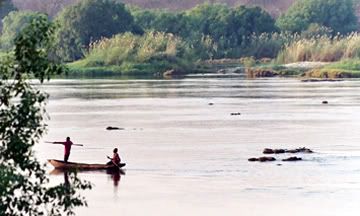“You can walk in that direction for 200 kilometers and not see another human being,” said Simon Wilde, pointing north into Zambia from the Zambezi River. The former safari guide was telling me about the countryside where David Livingstone first saw Victoria Falls in 1855, and how little it has changed since. The wide Zambezi is laced with rapids and dotted with islands big and small. It is home to crocodiles, surprisingly aggressive hippos, vicious tiger fish, and hundreds of flamboyant birds, not to mention native fishermen who still ply the mighty stream in makoros, dugout canoes identical to those their ancestors used. In the villages that dot the riverbanks, men still purchase brides for three cows and a little cash and build their homes with mopane poles, mud from termite mounds, and thatch roofs. Political boundaries exist now, but otherwise it hasn’t changed much since Livingstone made his journey more than 150 years ago.
The wide Zambezi is laced with rapids and dotted with islands big and small. It is home to crocodiles, surprisingly aggressive hippos, vicious tiger fish, and hundreds of flamboyant birds, not to mention native fishermen who still ply the mighty stream in makoros, dugout canoes identical to those their ancestors used. In the villages that dot the riverbanks, men still purchase brides for three cows and a little cash and build their homes with mopane poles, mud from termite mounds, and thatch roofs. Political boundaries exist now, but otherwise it hasn’t changed much since Livingstone made his journey more than 150 years ago.
November is barely the beginning of the rainy season in Zambia, so temperatures can reach 40 degrees Celsius (104 F) and the river is still low following the dry months of September and October. Livingstone first came at that time of year, so he and his party paddled through a sluggish four kph current on the Zambezi and navigated around heavy turbulence and exposed rocks in the rapids over the 117 kilometers (72 miles) of the journey.
Dave Donelson, author of Heart of Diamonds a romantic thriller about blood diamonds in the Congo
Sunday, March 23, 2008
Victoria Falls Through Livingstone's Eyes
Subscribe to:
Post Comments (Atom)







1 comment:
This looks so inviting, and so pristine, it is a pity we're not preserving the rest of our planet this way.
Post a Comment